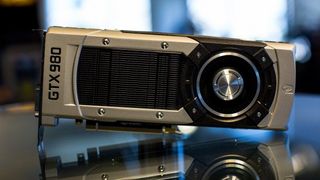Nvidia GTX 980 tested: SLI, 4K, and single-GPU benchmarks and impressions

The Nvidia GTX 980 is here—as in, Nvidia has announced it, you'll be able to buy one soon, and it's also physically here in the PC Gamer offices. I've been playing games on the GTX 980 and benchmarking the card with the help of Maximum PC. We've put our cards together to test dual-GPU SLI performance and thrown the 980s up against a 4K monitor to see how they compare to the GTX 780 Ti, Radeon R9 290X, and other top-of-the-line graphics cards.
The big question: is the Nvidia GTX 980 worth its $550 / £429 price tag? According to our benchmarks, absolutely.
First: the basic specs for both 900 series cards compared to some older Nvidia GPUs.
Specs | GTX 680 | GTX 780 | GTX 780 Ti | GTX 980 | GTX 970 |
CUDA cores | 1536 | 2304 | 2880 | 2048 | 1664 |
Base clock | 1006 MHz | 863 MHz | 876 | 1126 MHz | 1050 MHz |
Boost clock | 1058 MHz | 900 MHz | 928 | 1216 MHz | 1178 MHz |
Texture units | 192 | 128 | 192 | 128 | 104 |
Texture fill rate | 128.8 billion /s | 160.5 billion /s | 196.2 billion /s | 144 billion /s | 109 billion /s |
Single precision | 1 teraflop | 4 teraflops | 5 teraflops | 5 teraflops | 4 teraflops |
Memory config | 2GB 256-bit GDDR5 | 3GB 384-bit GDDR5 | 3GB 384-bit GDDR5 | 4GB 256-bit GDDR5 | 4GB 256-bit GDDR5 |
Memory speed | 6.0 Gbps | 6.0 Gbps | 7.0 Gbps | 7.0 Gbps | 7.0 Gbps |
TDP | 195W | 250W | 250W | 195W | 145W |
Power connectors | 2 x 6-pin | 1 x 6-pin, 1x 8-pin | 1 x 6-pin, 1x 8-pin | 2 x 6-pin | 2 x 6-pin |
Outputs | DisplayPort 1.2, HDMI, 2x dual-link DVI | DisplayPort 1.2, HDMI, 2x dual-link DVI | DisplayPort 1.2, HDMI, 2x dual-link DVI | 3x DisplayPort 1.2, HDMI 2.0, dual-link DVI | 3x DisplayPort 1.2, HDMI 2.0, dual-link DVI |
Launch price | $500 | $650 | $700 | $550 | $330 |
If you don't speak GPU specs, there are a few noteworthy numbers to hone in on above. The 900 series cards have notably higher clock speeds than the GTX 780, and each CUDA core is 40% more efficient, which makes up for the smaller number of cores. The new Maxwell architecture is also dramatically more power efficient than Kepler—the 980 can deliver 30 gigaflops per watt, versus just 15 gigaflops per watt for the 680 and 780. That's allowed Nvidia to bring the card's thermal design point down to 195 watts, and to once again run off two 6-pin connectors.
Some more information from Nvidia: Maxwell is built to work especially well at higher resolutions like 1600p and 4K. Memory architecture improvements and new color compression help Maxwell perform dramatically better than older cards when pushing more pixels. Nvidia's new MFAA is also lower impact than MSAA, which helps deliver playable framerates at 4K (though, at 4K pixel density, you may find you don't even care about AA at all).
That all sounds great, but do these cards perform as well in the wild as Nvidia claims? In a word: yes.
Jump over to the next page for a heap of benchmarks.
The biggest gaming news, reviews and hardware deals
Keep up to date with the most important stories and the best deals, as picked by the PC Gamer team.

Wes has been covering games and hardware for more than 10 years, first at tech sites like The Wirecutter and Tested before joining the PC Gamer team in 2014. Wes plays a little bit of everything, but he'll always jump at the chance to cover emulation and Japanese games.
When he's not obsessively optimizing and re-optimizing a tangle of conveyor belts in Satisfactory (it's really becoming a problem), he's probably playing a 20-year-old Final Fantasy or some opaque ASCII roguelike. With a focus on writing and editing features, he seeks out personal stories and in-depth histories from the corners of PC gaming and its niche communities. 50% pizza by volume (deep dish, to be specific).
Most Popular





